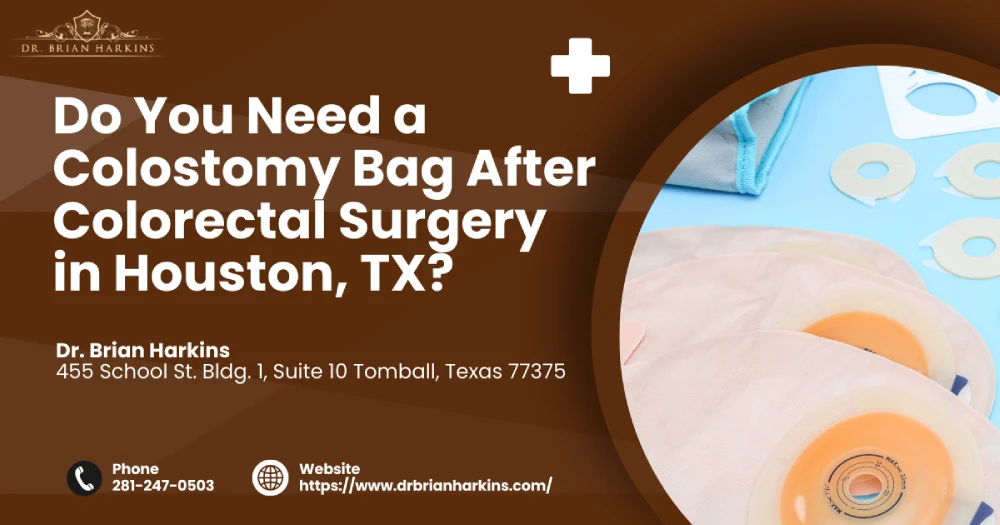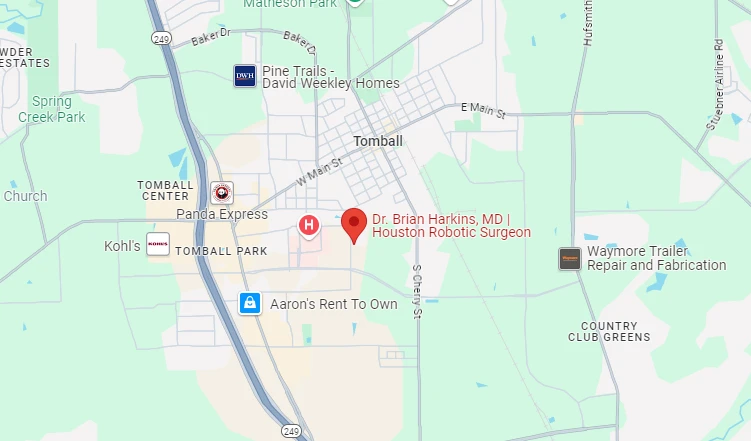
Do you need a colostomy bag after colorectal surgery in Houston, TX? The answer is not necessarily but depends on several factors, including the type of surgery performed, tumor location, and your body’s healing capacity. Thanks to modern advancements in robotic surgery, laparoscopic techniques, and personalized care plans, many Houston patients do not require a permanent colostomy after colorectal procedures. The need for a colostomy bag after colorectal surgery in Houston, TX, depends on the precise surgical procedure, the location and size of the tumor, and each patient’s healing profile. Houston patients benefit from a multidisciplinary care team that blends robotic surgery, laparoscopic instruments, and traditional open surgery when required. Because of these advances, most colon and rectal operations today no longer default to a permanent colostomy.
A colostomy is a surgical procedure in which part of the large intestine (colon) is diverted through the abdominal wall, forming a stoma that empties into an ostomy bag. When the opening comes from the small intestine, it is called an ileostomy. Surgeons create these diversions to bypass diseased bowel, protect a fresh anastomosis, or remove life-threatening infection.
The appliance—sometimes called a stoma bag or plastic bag—adheres to the skin and collects stool from the colon. Modern pouches are odor-proof, low profile, and allow cancer patients to swim, exercise, and work without fearing leaks.
| Surgical Scenario | Chance of Permanent Colostomy | Reason | Possible Alternative |
|---|---|---|---|
| Sigmoid colon cancer resection | Low | Sufficient healthy bowel for primary join | Stapled anastomosis with no ostomy |
| Tumor ≤2 cm from anus (rectal cancer) | Moderate–High | Sphincter muscle involved | Coloanal J-pouch, intersphincteric resection |
| Emergency perforation with contamination | Variable | High infection risk | Damage-control Hartmann’s, later reversal |
| Prior radiation, diabetes, smoking | Higher | Poor tissue healing | Prophylactic permanent stoma |
In short, the lower the tumor sits in the rectum and the more compromised the patient’s tissue, the higher the likelihood of receiving a colostomy. However, advances in minimally invasive surgery and meticulous surgical techniques continue to push those numbers down.
Most colorectal cancer surgery in Houston now relies on laparoscopic and robotic approaches. Small abdominal incisions, high-definition 3-D optics, and wristed robotic instruments permit precise dissection around the rectum, sparing nerves and blood supply. In certain colorectal cases—bulky tumors or extensive adhesions—traditional open surgery remains the safest route, yet even then, a permanent ostomy is not guaranteed.
LAR removes the diseased rectal segment while preserving the anal sphincter. Most surgeons add a temporary loop ileostomy as insurance against a leak. Once bowel scans show healing, colostomy reversal restores natural flow.
APR removes the entire rectum and anus; therefore, an end colostomy is permanent. Houston’s comprehensive cancer centers reserve APR for advanced rectal cancer invading sphincter muscles.
When cancer sits in the ascending or descending colon, surgeons excise part of the colon and reconnect the intestine immediately. Permanent colostomy is extremely rare in these operations.
Early rectal tumors can sometimes be removed through the anus using TAMIS. No abdominal incision, no ostomy, and same-day discharge make it a game-changer for select colorectal cancer patients.
The phrase “called a colostomy” sends many cancer patients into panic, yet close to 70 % of stomas created for rectal cancer in Houston are temporary. Reversal occurs once imaging confirms the anastomosis is intact, typically 8–12 weeks after the day of surgery.
The surgeon frees the intestine from the abdominal wall, reconnects bowel ends, and closes the skin. The operation is usually laparoscopic, lasting under two hours. Patients pass gas within 48 hours and often leave the medical center by postoperative day two.
Even for those who received a colostomy permanently, modern ostomy supplies, charcoal filters, and waterproof covers protect dignity and lifestyle. Houston WOC nurses offer individualized stoma care teaching so patients can travel, lift weights, and swim at Galveston Beach without fear.
Hours before the surgery, you'll meet anesthesia, review enhanced recovery milestones, and see your surgical team one last time. Most centers start IV antibiotics to protect against infection. After surgery, the care team focuses on early ambulation, gum chewing to stimulate bowel function, and multidisciplinary rounds that include your oncologist, dietitian, and physical therapist.
Postoperative care doesn’t end at discharge. Virtual visits allow your surgical team to diagnose and treat skin irritation, dehydration, or slow-to-wake intestine without another trip across town. Local support groups at every comprehensive cancer center in Houston connect you with fellow survivors who understand the journey.
Colorectal surgery no longer automatically equals a permanent colostomy. Thanks to minimally invasive surgery, robotic surgical platforms, and improved peri-operative care, most Houston patients either avoid a stoma or undergo timely colostomy reversal. For those who do require a permanent ostomy, modern technology and a robust cancer program ensure long-term quality of life remains excellent.
Yes. When perforated diverticulitis causes massive infection, surgeons may perform a Hartmann’s procedure, removing part of the colon and creating a temporary end colostomy. After the abdomen heals, many patients undergo another open or laparoscopic operation months later to reconnect the bowel.
Both diversions require similar ostomy bag systems, but ileostomy output is more liquid and occurs more often. Some patients prefer the thicker stool from a loop colostomy, while others like the smaller stoma of an ileostomy. Your care team will teach you hydration and electrolyte strategies either way.
Robotic systems provide 3-D magnification and wristed instruments that can sew deep in the pelvis without extra tension on the join. Better visualization of blood flow means the surgeon can select the healthiest part of the intestine to connect, reducing leaks and the need for protective ostomy.
Your oncologist collaborates with the surgical team to determine whether chemotherapy or radiation is needed postoperatively. This multidisciplinary approach ensures any microscopic cancer cells left behind are treated, improving survival while coordinating timing for possible colostomy reversal.
Initially you may sense movement or mild cramping as the bowel wakes up, but most patients stop noticing day-to-day output once they adjust. Modern pouches vent gas through charcoal filters, so noise and odor rarely become social issues.
Irrigation—flushing the colon through the stoma to control when stool exits—works best when the stoma originates from the descending or sigmoid colon. Your surgical team or WOC nurse can evaluate stoma location and teach the technique if you're a candidate.
Most people resume light cardio within three weeks and contact sports by six to eight weeks, provided their abdominal incision has healed and core strength is regained. Always follow individual guidance from your surgeon and physical therapist.
Extensive Crohn’s affecting the rectum can necessitate proctocolectomy with end ileostomy. However, many Houston specialists now use biologic medications to avoid surgery or limit resection length, preserving more intestine and reducing the ostomy rate.
A retracted stoma can cause leaks under the wafer. WOC nurses may recommend convex skin barriers, belt supports, or, in severe cases, a minor revision procedure. Early reporting of problems helps avoid skin breakdown.
High-volume, NCI-designated comprehensive cancer centers provide access to advanced imaging, robotic platforms, clinical trials, and dedicated colorectal anesthesia protocols. Studies show lower complication rates and higher five-year survival for patients treated at such facilities compared with low-volume hospitals.


Dr. Brian Harkins is a renowned surgeon specializing in advanced, minimally invasive, and robotic surgical techniques. With a dedication to innovation and personalized patient care, he has transformed countless lives by delivering exceptional outcomes.

I want a website like this, where do i start?